Explore Sharjah - United Arab Emirates (UAE) Travel, Asia
Sharjah, one of the seven emirates in the United Arab Emirates (UAE), offers a captivating blend of history, culture, and modernity. Known as the "Cultural Capital of the Arab World," Sharjah draws tourists with its rich heritage, stunning architecture, and vibrant arts scene. Unlike its neighboring cities, Sharjah maintains a deep connection to its roots while providing a wealth of experiences for travelers seeking authentic Arabian culture. Whether you’re a history buff, art enthusiast, or nature lover, Sharjah promises an unforgettable journey.
Population: Approximately 1.8 million in 2023.
Economy: Sharjah's economy is diverse, with key sectors including manufacturing, real estate, trade, and tourism. It is a business-friendly hub, supporting SMEs and fostering growth in culture and industry.
Landmarks: Famous for the Al Noor Mosque, Sharjah Museum of Islamic Civilization, the Sharjah Desert Park and Mleiha Archaeological Centre.
United Arab Emirates
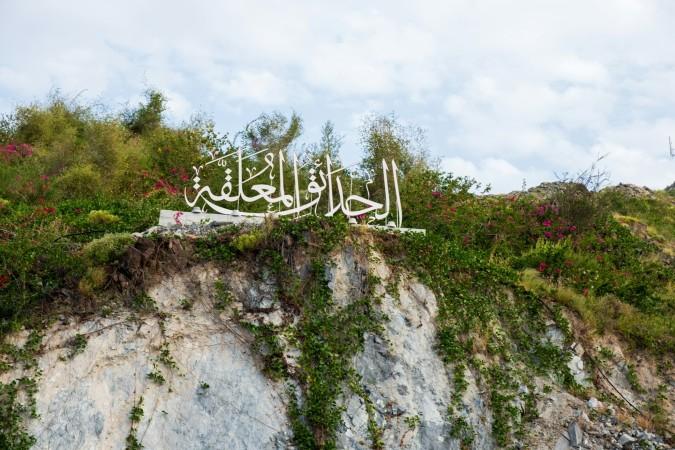
Overview of Sharjah
History & Cultural Influence
Sharjah’s history stretches back over 6,000 years, making it one of the oldest continuously inhabited regions in the Arabian Peninsula. As an important trading port during ancient times, it played a significant role in commerce between the East and the West. In 1998, UNESCO recognized Sharjah as the Cultural Capital of the Arab World, cementing its position as the epicenter of the UAE’s arts and heritage. The influence of both ancient Bedouin traditions and Islamic culture is evident in Sharjah’s architecture, festivals, and daily life. Its commitment to cultural preservation makes it stand out as a must-visit destination for travelers who want to understand the region's roots.
Interaction with the Locals
Sharjah, the third-largest emirate in the UAE, has a population of approximately 1.8 million people, with a diverse mix of expatriates and locals. Emirati citizens make up a smaller portion of the population, with the majority being expatriates from South Asia, the Middle East, and other regions. The local Emirati community is known for its strong cultural traditions, warm hospitality, and deep-rooted Islamic values, which are reflected in daily life and social customs throughout the emirate.
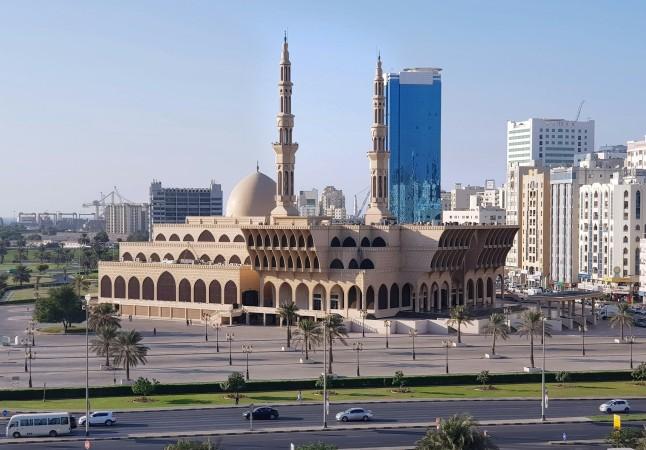
Al Noor Mosque, Sharjah - © Palani selvam
Top Attractions in Sharjah
Sharjah is home to a rich tapestry of cultural, historical, and natural wonders. The emirate offers a wide array of attractions that suit all types of travelers, from those passionate about art and history to families seeking fun and educational activities.
Al Noor Mosque
Situated along the Khalid Lagoon, Al Noor Mosque is one of Sharjah’s most famous landmarks, admired for its majestic domes and intricate minarets. Its Ottoman-inspired design draws architectural enthusiasts and photographers alike. While most mosques in Sharjah are not open to non-Muslims, Al Noor Mosque is an exception. Guided tours allow visitors to gain insight into Islamic culture, architecture, and religious practices, making it an educational experience for international tourists. Don't forget to dress modestly and respectfully, as it is an active place of worship.
Sharjah Museum of Islamic Civilization
Located near Corniche Street, this museum is housed in a grand building with a traditional Arab-Islamic design. Inside, you’ll find over 5,000 Islamic artifacts ranging from ancient manuscripts and textiles to scientific instruments and ceramics. One of the museum's standout features is its detailed exhibits on the Golden Age of Islamic civilization, showcasing how early Muslim scholars contributed to fields such as astronomy, medicine, and navigation.
Sharjah Desert Park and Mleiha Archaeological Centre
Located on the outskirts of the city, the Sharjah Desert Park offers a unique opportunity to explore the region's natural and historical heritage. The park includes a Natural History Museum, which introduces visitors to the flora and fauna of the Arabian Peninsula. Meanwhile, the Mleiha Archaeological Centre delves into Sharjah’s prehistoric past, showcasing fossils, ancient burial sites, and artifacts from early human settlements. Visitors can also participate in desert safaris, hiking, and stargazing tours for a more immersive experience.
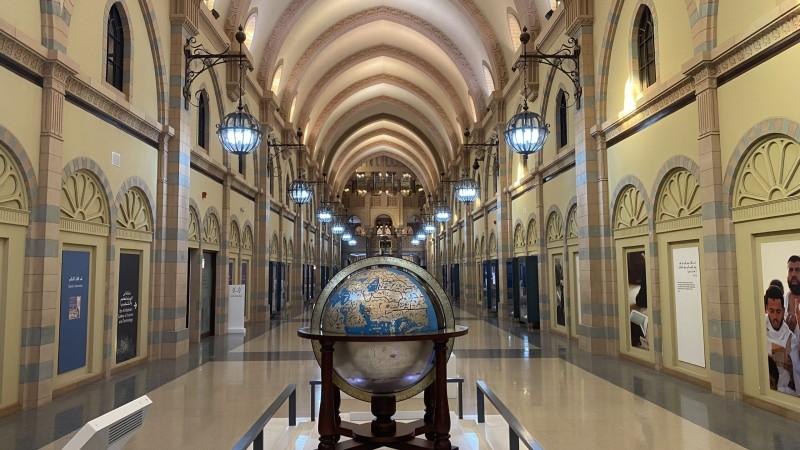
Sharjah Museum of Islamic Civilization - © Sandsplus L.L.C-FZE
Must-Try Dishes in Sharjah
Sharjah’s culinary tradition is a vibrant reflection of its rich cultural heritage, offering a diverse range of traditional Emirati dishes that combine bold flavors and time-honored cooking methods.
- Al Machboos: Al Machboos is one of the most popular traditional dishes in Sharjah. It consists of spiced rice cooked with tender lamb, chicken, or fish, and flavored with saffron, cardamom, and dried lemon (loomi). Slow-cooked for hours, the result is a flavorful and aromatic dish with a perfect balance of spices.
- Harees: Harees is a dish that dates back centuries and is commonly prepared during the holy month of Ramadan and Eid celebrations. Made by simmering wheat and meat (usually lamb or chicken) until the wheat breaks down into a porridge-like consistency, this hearty dish is simple yet filling.
- Luqaimat: Luqaimat, often served as a dessert or snack, are crispy on the outside and soft on the inside. These fried dough balls are typically drizzled with date syrup or honey and sprinkled with sesame seeds.
- Shawarma: Shawarma is a beloved street food not only in Sharjah but across the Middle East. It consists of thinly sliced meat (usually chicken or lamb) that’s roasted on a vertical spit, then wrapped in pita bread with garlic sauce, pickles, and salad.
- Balaleet: Balaleet is an Emirati breakfast dish that blends the sweet and savory in an unexpected way. It consists of sweetened vermicelli noodles cooked with sugar, cardamom, saffron, and rose water, served with a savory omelet on top.

Luqaimat - © Khaleej Times
Festivals & Local Celebrations
Sharjah Light Festival
Every February, Sharjah’s iconic buildings and landmarks are transformed into stunning canvases of light during the Sharjah Light Festival. This 10-day event showcases incredible light projections, turning historic sites like mosques, forts, and museums into dynamic works of art. The festival celebrates the fusion of art, technology, and history, drawing in tourists and locals alike to witness the breathtaking displays.
Eid Celebrations
Eid al-Fitr and Eid al-Adha are two of the most significant religious celebrations in the Islamic calendar. During Eid, Sharjah comes alive with special prayers, family gatherings, and festive meals. Visitors can experience the emirate’s vibrant cultural atmosphere through public events, including concerts, fireworks, and traditional performances.
Ramadan in Sharjah
During the holy month of Ramadan, Sharjah takes on a different rhythm. Fasting from dawn to sunset is observed, and the emirate offers a range of cultural and spiritual activities. At night, after breaking the fast with iftar meals, the streets come alive with Ramadan markets, cultural performances, and religious lectures. Visitors are encouraged to respect the customs of Ramadan and join in the communal celebrations.
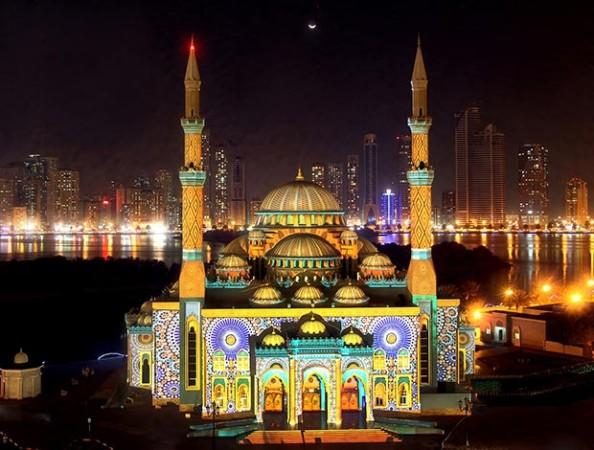
Sharjah Light Festival - © Islamic Arts Magazine
What to Do in Sharjah
- Desert Safaris and Dune Bashing: One of the most thrilling activities Sharjah offers is a desert safari. Visitors can explore the vast sand dunes on a 4x4 adventure, known as dune bashing, or enjoy a more leisurely camel ride across the golden landscapes.
- Stroll Along Al Majaz Waterfront: The Al Majaz Waterfront is a popular spot for families and couples looking to unwind. It features beautiful walking paths, green spaces, and views of the Khalid Lagoon. You can rent a bike, take a boat ride, or simply enjoy a meal at one of the many restaurants while watching the Sharjah Fountain Show.
- Explore Al Noor Island: Al Noor Island is a unique destination that combines nature, art, and architecture. Stroll through the lush Butterfly House, admire the contemporary sculptures, or relax in the peaceful gardens. It’s a great place to recharge and connect with nature in the midst of Sharjah’s urban landscape.
Shopping in Sharjah
- Souq Al Arsah: Souq Al Arsah is a traditional market that offers a glimpse into Sharjah’s past. Wander through its narrow alleys and discover shops selling everything from antiques and handicrafts to perfumes and jewelry.
- Central Souq (Blue Souk): One of Sharjah’s most famous shopping destinations, the Central Souq, also known as the Blue Souk, is a two-story building adorned with stunning Islamic architecture. Inside, you’ll find a wide array of traditional goods, including carpets, textiles, and gold jewelry.
- Sahara Centre: If you’re looking for a more contemporary shopping experience, Sahara Centre offers a wide range of international brands, from fashion to electronics. The mall also features a variety of dining options, a cinema, and entertainment facilities for families, making it a one-stop destination for both shopping and leisure.
- City Centre Sharjah: City Centre Sharjah is another modern shopping complex, popular for its accessibility and range of global retail outlets. From fashion and electronics to groceries and lifestyle products, it caters to both locals and tourists.
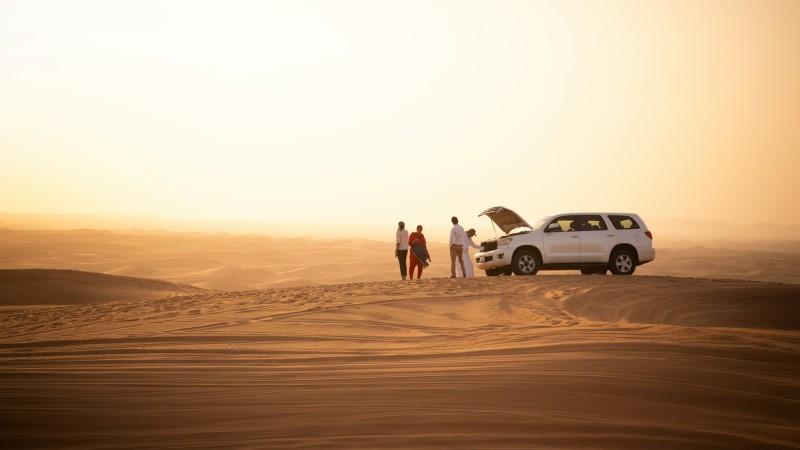
Desert Safaris around Sharjah - © Danish Puri
Weather in Sharjah: Best Time to Visit
Summer in Sharjah
During the summer months, temperatures in Sharjah can soar well above 40°C (104°F), with humidity levels often making it feel even hotter. Outdoor activities, like desert safaris and sightseeing, can be challenging during this time. However, this is a good time to enjoy indoor attractions like museums, malls, and cultural centers, as they’re all air-conditioned.
Winter in Sharjah
Winter is the best time to visit Sharjah, as the weather is mild and ideal for outdoor activities. Daytime temperatures range between 18°C to 28°C (64°F to 82°F), making it perfect for exploring the city’s landmarks, beaches, and desert parks. This season also hosts major festivals like the Sharjah Light Festival.
Spring and Autumn in Sharjah
Spring and autumn serve as transitional periods between the intense summer heat and the mild winter. The weather during these times is generally warm but manageable, with temperature around 25°C to 35°C (77°F to 95°F)making it a good time for tourists who prefer fewer crowds. It’s a great season for cultural events and festivals that occur before the peak tourist season.
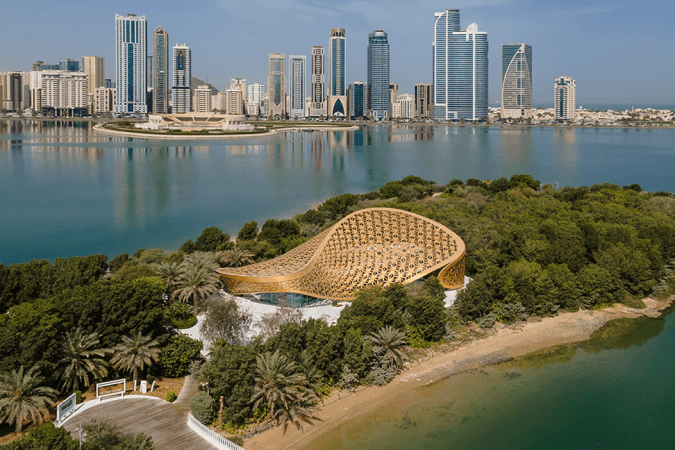
Explore Al Noor Island to hide from the heat of the desert - © Al Noor Island Official website
Essential Travel Information
Getting Around Sharjah
- Public Buses: Sharjah’s bus network is extensive, connecting the city’s major attractions, shopping areas, and neighborhoods. Tourists can purchase Sayer Cards, a rechargeable smart card used to pay for fares.
- Taxis: Taxis are widely available across Sharjah and are a convenient option for tourists. They’re metered, affordable, and safe, with most drivers speaking basic English. Taxis are especially useful for traveling to locations not easily accessible by bus or for short trips within the city.
- Car Rentals: Renting a car is a great option if you plan to explore Sharjah at your own pace or venture into other emirates like Dubai or Abu Dhabi. Several international and local car rental companies operate in Sharjah, with daily and weekly rental options.
ATM & Banking Services
Sharjah offers convenient access to banking services and ATMs throughout the city, making it easy for tourists to manage their finances during their stay. ATMs are widely available in shopping malls, airports, hotels, and tourist areas, and most machines accept major international debit and credit cards. While ATMs typically provide a favorable exchange rate, currency exchange services can also be found in popular locations, offering competitive rates for foreign currency.
Where to Stay in Sharjah
- Luxury Hotels: Sharjah boasts several high-end hotels and resorts, offering premium amenities, stunning views, and top-notch service. These luxury options are often located near the beach or key cultural attractions, combining traditional Emirati hospitality with modern conveniences.
- Mid-Range Hotels: These hotels typically offer modern amenities such as free Wi-Fi, restaurants, fitness centers, and easy access to major landmarks. Ideal for families, business travelers, and tourists alike, these accommodations offer excellent service at reasonable rates.
- Budget Accommodation: Budget-conscious visitors will find plenty of affordable accommodation options, from basic hotels to guesthouses and hostels. These options provide clean and comfortable rooms with essential amenities, making them perfect for backpackers or travelers looking to explore Sharjah on a smaller budget.
Articles for you

Explore Yala National Park - Sri Lanka Travel, Asia
Tucked away in Sri Lanka’s southeastern corner, Yala National Park is where wild nature meets deep tradition. Known worldwide for its leopard population, the park is also home to elephants, sloth bears, crocodiles, and hundreds of bird species. Beyond wildlife, Yala opens doors to a cultural landscape dotted with ancient temples, Buddhist ruins, and coastal villages. For travelers seeking more than just a safari, Yala offers a chance to explore eco-tourism, local communities, and sacred heritage sites.
Population: The Yala National Park area doesn’t have a human population.
Economy: The economy around Yala National Park thrives on a blend of eco-tourism, agriculture, and local services. Safari tours, eco-lodges, and cultural experiences drive steady income for nearby towns like Tissamaharama and Kataragama, supporting thousands of families.
Landmarks: Famous for Block I of Yala and wildlife encounters, including elephants, sloth bears, crocodiles, and exotic bird species.

Explore Galle - Sri Lanka Travel, Asia
Nestled on Sri Lanka’s southern coastline, Galle is a vibrant city where history meets the sea. Its cobbled streets, colonial architecture, and serene beaches make it a must-visit destination for travelers seeking a blend of culture, adventure, and relaxation. A UNESCO World Heritage site, Galle captivates visitors with its Dutch Fort, bustling markets, and friendly locals. Whether you’re exploring the ramparts at sunset or savoring fresh seafood by the shore, Galle promises an unforgettable journey into Sri Lanka’s heritage.
Population: Approximately 113,000 in 2023.
Economy: Galle’s economy thrives on tourism, trade, and fisheries. The city’s historic fort, colonial architecture, and coastal charm draw thousands of international visitors each year, making tourism its main economic driver. Fishing remains vital for local livelihoods, supplying fresh seafood across the region.
Landmarks: Famous for the Galle Fort, Dutch Reformed Church & Maritime Museum, and Unawatuna Beach.

Explore Bentota - Sri Lanka Travel, Asia
Nestled along Sri Lanka’s southwestern coast, Bentota is a tropical paradise that blends golden beaches, vibrant culture, and thrilling adventures. Famous for its calm waters, luxury resorts, and scenic river estuary, Bentota has become a top destination for travelers seeking both relaxation and authentic experiences. From serene beach walks at sunrise to adrenaline-pumping water sports, this coastal town offers a perfect balance of leisure and exploration. With its proximity to Colombo and Galle, Bentota is easy to reach, making it an ideal stop for both short escapes and extended holidays.
Population: Approximately 37,000 in 2023.
Economy: Bentota’s economy thrives mainly on tourism, which drives local businesses such as hotels, restaurants, and wellness retreats. The town also benefits from fishing, coconut cultivation, and handicrafts like wood carving and batik textiles. Many residents rely on the growing demand for water sports and Ayurvedic treatments, making tourism the backbone of both income and employment in the area.
Landmarks: Famous for Bentota Beach, Bentota River Safari, and Kande Vihara Temple.

Explore Mirissa - Sri Lanka Travel, Asia
Mirissa is a charming coastal town on Sri Lanka’s southern shoreline. Known for its golden beaches, turquoise waters, and vibrant marine life, it has become a must-visit stop for travelers exploring the island. Many come for whale watching, surfing, and sunset views at Coconut Tree Hill, but Mirissa offers much more than postcard beauty. The fishing boats you see anchored by the bay carry generations of stories. Local traditions, delicious cuisine, and a laid-back rhythm of life shape every visitor’s experience.
Population: Approximately 4,700 in 2023.
Economy: Mirissa’s economy is largely shaped by its coastal location. Fishing has long been the backbone of local livelihoods, with generations relying on the Indian Ocean for income. In recent decades, tourism has become the main driver of growth, thanks to whale watching, surfing, and beachside hospitality.
Landmarks: Famous for Mirissa Beach, Coconut Tree Hill, and Parrot Rock Bridge.

Explore Nuwara Eliya - Sri Lanka Travel, Asia
Tucked away in the Central Highlands of Sri Lanka, Nuwara Eliya is often called “Little England”. With its rolling tea plantations, cool misty mornings, and colonial charm, this mountain town feels like a step into another world. Travelers come here to breathe fresh air, walk through flower gardens, sip the finest Ceylon Tea, and enjoy a pace of life far from the island’s busy cities. Whether you’re drawn by scenic landscapes, heritage architecture, or the warmth of its people, Nuwara Eliya is a destination that blends nature, culture, and history in perfect harmony.
Population: Approximately 781,000 in 2023.
Economy: Nuwara Eliya’s economy thrives mainly on tea production, as it sits in the heart of Sri Lanka’s central highlands, famous worldwide for Ceylon Tea. The city also benefits from a growing tourism industry, attracting visitors with its colonial charm, cool climate, and scenic landscapes.
Landmarks: Famous for Gregory Lake, Hakgala Botanical Garden, and Victoria Park.

Explore Sukau - Malaysia Travel, Asia
Nestled on the banks of the Kinabatangan River in Sabah, Malaysian Borneo, Sukau is a destination where wildlife, culture, and conservation come together. Known as one of Asia’s top spots for river safaris and eco-tourism, this quiet village offers a front-row seat to encounters with Bornean orangutans, pygmy elephants, proboscis monkeys, and exotic birdlife.
Population: Approximately 1,400 in 2019.
Economy: Sukau’s economy is shaped by its riverine location and natural resources. Traditionally, the Orang Sungai community relied on fishing, small-scale farming, and forest gathering for their livelihood. Today, the village has shifted toward eco-tourism, with river cruises, jungle trekking, and homestays providing income.
Landmarks: Famous for the Kinabatangan River cruises, Gomantong Caves, and Ox-bow lakes and wetlands.
